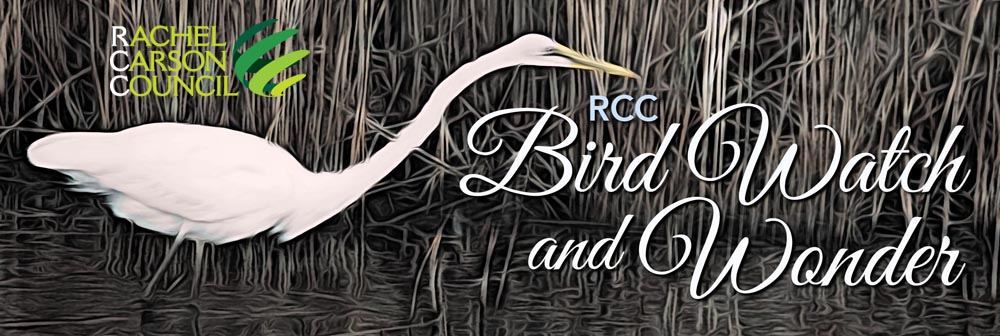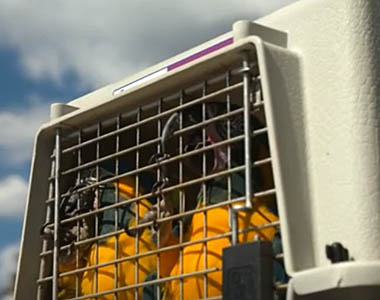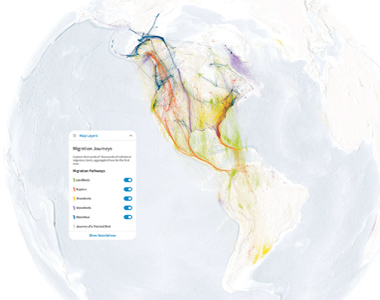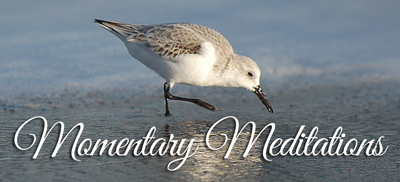 | | |  Welcome to the October edition of RCC’s Bird Watch and Wonder! This month, we have added a special section dedicated to Hurricane Ian and its impact on birds, as well as resources for those affected, or who want to help. Hurricane Ian has been the deadliest hurricane to hit Florida since 1935 and caused significant damage to Cuba and the eastern United States. During this environmental disaster, residents banded together to help save parrots from a sanctuary on Pine Island that had been cut off from all resources and aid. Volunteers stayed behind to ensure the safety of zoo animals, including an array of different bird species. Welcome to the October edition of RCC’s Bird Watch and Wonder! This month, we have added a special section dedicated to Hurricane Ian and its impact on birds, as well as resources for those affected, or who want to help. Hurricane Ian has been the deadliest hurricane to hit Florida since 1935 and caused significant damage to Cuba and the eastern United States. During this environmental disaster, residents banded together to help save parrots from a sanctuary on Pine Island that had been cut off from all resources and aid. Volunteers stayed behind to ensure the safety of zoo animals, including an array of different bird species.  Climate change is also affecting bird songs, as you will see in our “Bird Findings” section. For more information on climate change and how it is affecting your favorite birds, also check out “Bird Lore” featuring an article written by RCC Presidential Fellow Maggie Dees. But there is good news as well. The Migratory Birds of the Americas Conservation Enhancements Act has been introduced in the House of Representative. If passed, it will aid in the conservation of over 300 neotropical bird species. The Clean Water Act is also turning 50 and, in celebration, the “Bird Ecology” section shows how it has benefited birds throughout its existence. As bird migration season continues, your can also track hawk migration and interact with bird migration in “Birds and our World.” Climate change is also affecting bird songs, as you will see in our “Bird Findings” section. For more information on climate change and how it is affecting your favorite birds, also check out “Bird Lore” featuring an article written by RCC Presidential Fellow Maggie Dees. But there is good news as well. The Migratory Birds of the Americas Conservation Enhancements Act has been introduced in the House of Representative. If passed, it will aid in the conservation of over 300 neotropical bird species. The Clean Water Act is also turning 50 and, in celebration, the “Bird Ecology” section shows how it has benefited birds throughout its existence. As bird migration season continues, your can also track hawk migration and interact with bird migration in “Birds and our World.” Then be sure to read the latest from bird raconteur Ross Feldner and his close encounters with Whooping Cranes. And, if you ever wondered what one of those old, fine-print vintage bird guides would have looked like had it been able to include colorful bird paintings, head to the end of our October issue of Bird Watch and Wonder. Then savor stunning works of art that highlight the beauty of birds. | | | | | | | | | | Rescuers Flock Together to Save 275 Parrots Stranded by Ian Will Peratino and his partner Lauren Stepp would not leave their Pine Island compound, even as authorities pleaded with residents to abandon their homes because of damaged roads, including a collapsed bridge that prevented deliveries of food, gas and other life-sustaining supplies. But the couple could not leave without their two lemurs and flock of birds — 275 parrots, including some of the world's rarest. So a rescue mission — dubbed “Operation Noah's Ark” — was launched Tuesday to catch, cage and ferry the birds off the island. | | | | | | What Happened to Our Local Birds During Hurricane Ian? Sarasota Audubon Society president Jeanne Dubi tells us how our resident birds handle disaster. News and reports of devastation from Hurricane Ian continue to roll in. Images of flooded roads, roofless house and downed power lines make up a majority of what we see—but the animals that share Florida with us are also affected by storms. So where do all the critters go when a hurricane strikes? They’re not watching the news and getting evacuation orders. They have no homes to board up. How do they survive? | | | | | | What’s Been Happening With Animals in Florida During Hurricane Ian? From sharks to storks and stranded cats, wild and captive creatures have shown up in unexpected places due to the intense storm. The zookeepers were deliberate, wrapping her head in a blanket. One clenched shut her massive beak, another secured her slender legs, and a third gripped around her folded wings as they guided her to a cart. Odette the shoebill stork would be safe from the coming storm. | | | | | | Hurricane Ian Relief Fund “NEED RELIEF?” Florida’s Hurricane Ian victims wonder how they will make it through the next week. What they will do for food, water, and how they will start to rebuild their lives. Charities like Reboot make a critical difference at times like these. As survivors begin to emerge from their shelters and take stock of their new situation……a cavalry of volunteers is already on their way with water, food, medicine, supplies, tools – and just as importantly, comfort and hope. | | | | | | | | | | Do Birds Feel Grief? The issue of birds having emotions has been controversial, but many say they do mourn the loss of a partner. It started with a question from a reader: "Do birds mourn?" He described a scene at the family cabin, where a pair of barn swallows had been nesting under the deck. Unfortunately, one of the pair was killed in a collision with a cabin window. The other swallow then seemed to be holding a vigil, sitting halfway between its dead partner and its nest for some time. | | | | | | Climate Change Could Quiet Prairie Birds’ Chirping Virtual model predicts birdsong is dampened by drought-induced drier air A bird sings on the prairie and nobody can hear it. Forget whether it makes a sound—biologists want to know why it went unheard. Drier conditions intensified by climate change might be responsible, a new study finds, because birdsong doesn’t travel as far in dry air. That could have harmful consequences for birds trying to defend their territories or find a mate. | | | | | | Migrating Birds Drawn by Light Face Higher Chemical Exposure Birds attracted by the glow of artificial light at night are drawn into areas where they are also exposed to higher concentrations of airborne toxic chemicals, according to a new study. "We examined the correlation between the concentration of airborne toxic chemicals, artificial light at night, and the weekly abundance of 165 nocturnally migrating songbird species," said Frank La Sorte, a research associate at the Cornell Lab of Ornithology and lead author of the study in Global Change Biology. | | | | | | | | | | | | | Members of the Audubon Society have addressed key members of Congress on this issue, we need to add to their momentum. Seabirds populations all over the world have declined precipitously by 70 percent over the last 70 years. Ocean temperatures continue to rise and make life harder for Atlantic Puffins nesting in Maine. Since 2021, only half the normal number of puffin chicks have survived. Urge your members of Congress to protect the
coastal habitats and fish that seabirds count on.  Many seabirds are in trouble due to shrinking food sources and habitat loss. Many species including the Atlantic Puffin rely on forage fish for food. These fish are the base of the ocean food chain and are threatened by climate change and human overfishing. This means seabirds don’t have enough to eat and habitats like wetlands, estuaries and mud flats are shrinking due to coastal development and climate change. Seabirds rely on these environments to rest during migration and forage for food. We must update the Magnuson-Stevens Fishery Conservation and Management Act! This is our nation’s only federal fisheries law and it’s needed to protect the forage fish in the ocean that seabirds need to survive as well as protect seabirds from fishing gear entanglements and other fishing hazards.  | | | | | | | | | | EPA Decision Maintains Dangerous Regulatory Loophole for Pesticide-Coated Seeds Many crop seeds are coated with toxic insecticides called neonicotinoids, which threaten seed- and insect-eating birds while providing few benefits to crops. The Environmental Protection Agency (EPA) today denied a petition request from American Bird Conservancy (ABC) and other parties seeking to change a dangerous regulatory loophole for pesticide-coated seeds. Instead of regulating these coated seeds as the agency does other pesticide uses, the EPA says it will review labeling language and requirements. | | | | | | Birds Are Heading South For the Winter. Here’s How You Can Help Them on Their Journey! World Migratory Bird Day is celebrated twice a year on the second Saturday of May and Oct. The day is dedicated to the importance of bird conservation, as it is also a busy time of the year with birds migrating south. The theme of this year’s day is light pollution. Light pollution can disorient nocturnal migrating birds. This makes the birds more likely to land in areas where they could be more vulnerable to collisions and other things. At least 100 million birds die from colliding with buildings every year | | | | | | The Migratory Birds of the Americas Conservation Enhancements Act is Introduced in the House House bill will address urgent conservation needs for migratory birds in the United States, Latin America, and the Caribbean. This week, Congressman Ron Kind and Congresswoman Maria Elvira Salazar introduced H.R. 9135, the Migratory Birds of the Americas Conservation Enhancements Act, in the House of Representatives. This bipartisan bill will enhance the Neotropical Migratory Bird Conservation Act (NMBCA). | | | | | | Systemic Barriers Hinder Bird Research, Say 124 Latin American Ornithologists A new preprint from scientists across the region asserts that advances in neotropical ornithology will require a stronger commitment to inclusion. When Lourdes Mugica Valdés was finishing her master’s thesis with fieldwork in Cuba in 1992, she lost 70 pounds. Due to the Cuban economic crisis, there was little food to eat. One day, she says, the only calories her team could find near the bird communities they were monitoring was a bottle of wine. The cars they relied on would often break down. Sometimes, they had to bike. | | | | | | Good News: A Good Year For Puffins and Terns, Despite Climate Change The title of supervisory wildlife biologist for the United States Fish and Wildlife Service does little justice to Linda Welch (pictured above). In practice, she is the housing and unusual development secretary for seabirds on Maine’s Petit Manan Island. This was clear as she led me to nesting areas there for Atlantic puffins. Over the last half century, the bird has been restored from the brink of extinction in Maine, the only state where it breeds. Petit Manan is located about 20 miles east of Acadia National Park and is part of the Maine Coastal Islands National Wildlife Refuge. | | | | | | | | | | | | Shifts in Distribution of Bird Species Due to Climate Change May Compromise Ecosystem Services Issue 586: As species’ ranges shift due to climate change, ecosystems will be altered and may change how they function. This study uses a large data set to model changes in the ecological roles performed by bird species in ecosystems around the world. The researchers report that forecast changes in ecological function vary across geographic areas. They suggest possible implications of these findings for future provision of ecosystem services. | | | | | | The Clean Water Act at 50 and What it Means for Birds A look ahead at what’s working, what’s not, and where we go from here. This week, we’re celebrating the Clean Water Act’s 50th birthday—and half a century of protecting America’s waters. It is hard to overstate how critical this legislation was and is in reducing the amount of pollution flowing into our rivers, lakes, streams, and wetlands. Here at Audubon, we know birds and communities need access to clean water, which is why this bipartisan legislation is so critical—ensuring clean and abundant water in rivers, lakes, streams, wetlands, and marshes. | | | | | | | | Whooping Crane: Back from the Brink of Extinction Before humans began altering their habitat, it is estimated there were 15,000 to 20,000 Whooping Cranes. By the 1800’s and early 1900s, hunting and habitat loss began to reduce their numbers drastically. By 1860 there were only about 1,400 and in 1941 their population had fallen to the shockingly low number of 15! It seemed they were on the verge of extinction. These last few survivors were all part of a single flock that migrated between Canada and Texas. | | | | | | Joy Is the Justice We Give Ourselves Joy is the justice we give ourselves. It is Maya’s caged bird sung free past the prison bars, holding spirits bound—without due process, without just cause. Joy is the steady run stream, rights sprung up through moss-soft ground—water seeping sweet, equality made clear from sea to shining sea, north to south, west to east. | | | | | | What Color is a Blue Heron?
I always thought the great blue heron was more gray-blue than blue-gray. My perspective changed as I watched this heron just as the first rays of morning reached its resting place in a shady marsh. | | | | | | | | Is Climate Change Changing the Birds We See? Breaking news! A bird you have never seen or heard before is going extinct in a remote part of the world! While I am sure we can all agree that it is terrible for these birds, we can still enjoy the beauty of our most beloved backyard and local birds without experiencing the loss of those more exotic ones. Nevertheless, I hate to be the bearer of bad news. Climate change is a threat to all species, whether or not we can directly see the impacts. Think of a relaxing day on the beach, watching Piping Plovers and Sanderling frolic along the sand. Or perhaps on vacation watching those darling Atlantic Puffins on the rocks seen from a tour boat. Things look OK, right | | | | | | The Bird Migration Explorer Lets You Interact With Nature’s Most Amazing Feat With this revolutionary new tool, anyone can follow hundreds of species on their epic journeys and discover challenges they face along the way. Humans have long been captivated by migratory birds, awed by the animals’ biannual treks between their breeding and wintering grounds. A new digital platform, the Bird Migration Explorer, brings this natural phenomenon to your screen, enabling you to pore over the movements of individual species, discover the birds at a specific location, and learn about challenges these far-flying creatures face. | | | | | | Autumn Hawk Migration Hawk Mountain's Autumn Migration Hawk Count is the longest running raptor migration count in the world. It began in 1934, when founder Rosalie Edge hired a curator named Maurice Broun, and he started meticulously keeping track of the passing migrants. Today, Sanctuary staff, trainees, and volunteers are stationed at the lookouts to help visitors spot and identify raptors, including hawks, eagles, falcons, and vultures. The count runs from August 15 through December 15. For raptor enthusiasts and those who cannot make it to Hawk Mountain, daily counts are posted throughout the season here. People living near the Del-MD-VA area click here for a great place to hawk watch. | | | | | | California’s Drought is Upending Migration for Millions of Birds Along the Pacific Flyway. Here’s How Bad It Is. Millions of migratory birds fly south each year to winter in California, or continue beyond. The white-faced ibis is one of the first. The large wading bird with its distinctive curved bill, like its avian counterparts that fill the sky in late summer and fall, relies on the state’s wetlands to rest and recharge. But this year, the ibis that arrived at the California-Oregon border from points north didn’t find the marshes and ponds they’re accustomed to, just dust and dried-up mud. | | | | | | 12 Ways the Inflation Reduction Act Will Benefit Birds and People The historic legislation will reduce carbon pollution, create jobs, and build new protections from climate threats for birds, people, and the places we need. The name doesn’t make it obvious, but the Inflation Reduction Act is the most significant climate legislation ever to become law. It also does a lot of other important things. Here are 12 ways this bill benefits birds, people, and the places we need. | | | | | | Supreme Court Ruling is Bad News for Birds and Everyone Else, Too The court’s ruling in the West Virginia v. Environmental Protection Agency case limits our ability to respond to the climate crisis and could have other serious implications. “This ruling by the Supreme Court directly threatens our ability to protect birds, people, and the places we need,” said Marshall Johnson, chief conservation officer, National Audubon Society. “Birds are telling us that the climate is changing and more action is needed. Stripping agencies like the EPA of their ability to respond to these real and urgent threats puts our communities, birds, and other wildlife at greater risk.” | | | | | |  | | | Artist Adds Exquisite Bird Paintings To Vintage Book Pages That Describe Them Vintage book pages merge with realistic renditions of birds in the art of Craig Williams. The Australia-based painter sources these unconventional canvases to create intentional juxtapositions between his art and printed text. This thoughtful combination results in pairings that appear to have been made for each other. Williams brings his background in zoology and experience working in museums and wildlife parks into his creative practice. | | | | | | | | The October 2022 issue of Bird Watch and Wonder was produced by RCC Stanback Presidential Fellow Maggie Dees and Ross Feldner
 RCC Stanback Presidential Fellow – Maggie Dees RCC Stanback Presidential Fellow – Maggie Dees
Maggie Dees co-leads the RCC Bird Watch and Wonder program. She is a sophomore in the honors program at Virginia Tech University majoring in environmental science. She is from Salisbury, NC, and is passionate about environmental justice and conservation. | | | | | |  The Rachel Carson Council Depends on Tax-deductible Gifts From Concerned Individuals Like You. Please Help If You can. The Rachel Carson Council Depends on Tax-deductible Gifts From Concerned Individuals Like You. Please Help If You can. | | | |  Sign Up Here to Receive the RCC E-News and Other RCC Newsletters, Information and Alerts. Sign Up Here to Receive the RCC E-News and Other RCC Newsletters, Information and Alerts. | | | | | | | | | | | |